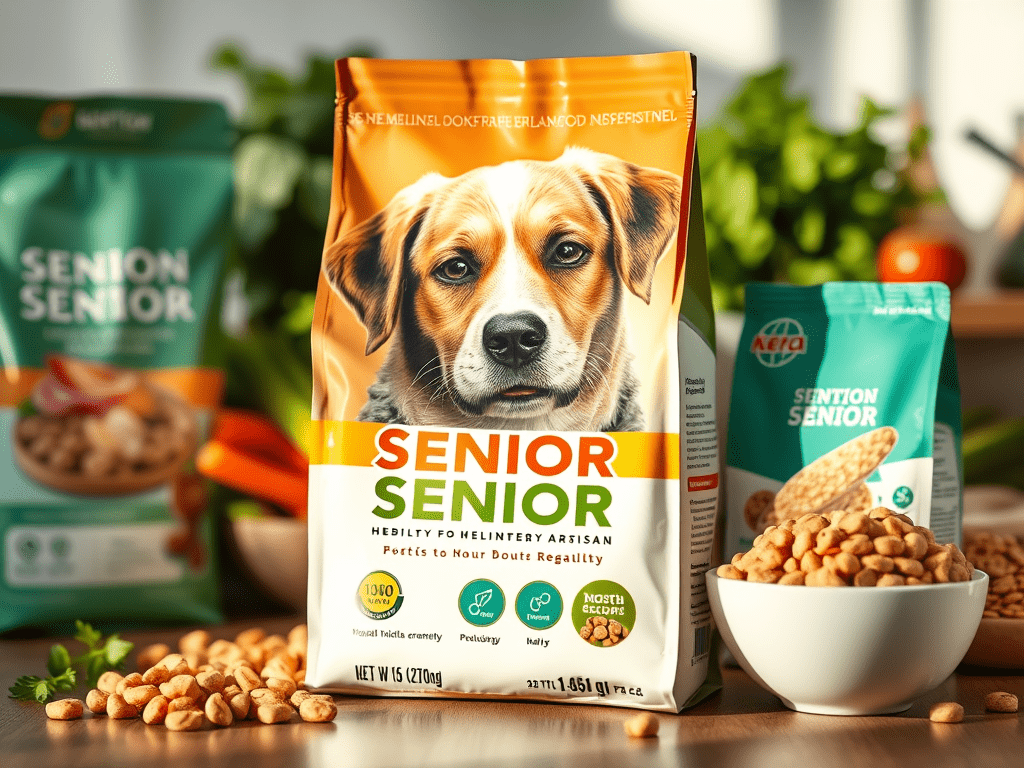When your dog starts aging, one question naturally comes to mind — “Should I switch to senior dog food now?” If you’re asking that, you’re not alone. Many pet parents are confused about the difference between senior dog food and regular food. You may also wonder, does senior dog food make a difference? The answer is yes — and here’s why.
This guide will help you clearly understand the difference between senior dog food and regular dog food, why it matters, when to switch, and which brands offer good choices.

What is Regular Dog Food?
Regular dog food usually refers to adult dog food, made for healthy, active dogs aged 1 to around 6–7 years. It’s packed with energy, balanced nutrients, protein, fat, and fiber to support an adult dog’s metabolism and muscle activity.
So if your dog is still young and active, regular dog food works well. But as dogs age, their dietary needs change — just like ours.
What is Senior Dog Food?
Senior dog food is specially made for aging dogs, usually 7 years and older (or 5–6 years in large breeds). It focuses on health support like joint care, digestion, weight management, and immune support.
Now you’re probably asking:
How is senior dog food different from regular dog food?
Let’s explore the real difference between senior dog food and regular — not just in name but in purpose.
Key Differences Between Senior and Regular Dog Food
1. Protein Levels and Sources
Senior dogs need quality protein, but not too much. Their digestion slows down, and kidneys work harder. So senior dog food vs regular shows a shift to easier-to-digest protein sources.
Many formulas use chicken-free options or go for salmon and lamb, which are gentle on older stomachs.
For example:
- Blue Buffalo senior dog food vs regular shows more antioxidant blends and easy proteins in the senior formula.
- Brands like Nutro and Science Diet adjust protein levels and sources in their senior recipes.
2. Lower Fat and Calories
Older dogs are less active. Feeding them regular adult food can lead to weight gain. That’s where the difference between senior dog food and regular dog food matters — senior food has fewer calories and helps maintain weight without sacrificing nutrients.
3. Joint and Mobility Support
A big difference between senior dog food and regular is added glucosamine and chondroitin, which help support aging joints.
You’ll notice this in brands like:
- Purina Pro Plan senior dog food
- Hill’s Science Diet senior dog food
- Royal Canin senior dog food
These include ingredients for joint cushioning, making movement easier for your older dog.
4. Fiber and Digestive Health
Older dogs may face tummy troubles or constipation. So, senior formulas have more fiber and prebiotics for digestion.
You’ll see:
- Senior dog food large breed sensitive stomach formulas
- Special dry senior dog food blends with gentle fiber
5. Special Ingredients for Brain and Immune Health
Senior foods often include antioxidants, omega-3 fatty acids, and even MCT oils (like in Purina Bright Mind) to help with brain sharpness and immunity. That’s something most regular dog food doesn’t include.
Does Senior Dog Food Make a Difference?
Yes, it does — a big one. If your dog is aging, switching to senior food helps support:
- Healthy weight
- Easier digestion
- Joint health
- Better mental focus
So if you’re asking, does senior dog food make a difference? — absolutely. You might not see changes overnight, but over time, your dog will move better, feel lighter, and stay healthier.
When Should You Switch to Senior Dog Food?
Typically, dogs are considered senior around:
- 7 years for most medium breeds
- 5–6 years for large breeds
So if your pup is slowing down, has joint stiffness, or digestion issues — it’s time to consider senior food.
Don’t worry — many dogs love the soft texture and salmon-based flavors in senior formulas. Some even prefer it!
Real Brand Examples: Senior Dog Food vs Regular
Let’s take a closer look at how brands adjust their recipes to match aging needs:
Blue Buffalo Senior Dog Food vs Regular
Blue Buffalo’s senior recipe adds:
- More antioxidants
- Less fat
- Joint supplements
It also cuts down on chicken for sensitive dogs.
Iams Senior Dog Food Large Breed vs Adult
Iams senior includes:
- Extra fiber
- Fewer calories
- Glucosamine
Science Diet Senior Dog Food vs Adult
Hill’s Science Diet senior foods include:
- Better heart & kidney support
- DHA & antioxidants for brain health
These differences help keep your older dog energetic without the risk of weight gain or joint pain.

What About Large Breed Dogs?
Large breeds age faster and face more bone and joint stress. So, choosing between senior dog food vs regular dog food matters even more for them.
You’ll find special products like:
- Senior dog food large breed no chicken
- Senior dog food large breed soft
- Senior dog food large breed salmon
- Senior dog food large breed reviews that focus on joint and mobility support
Large breed formulas usually have:
- Extra glucosamine
- Controlled calories
- Easy-to-chew kibble
- Better digestion aids
You can even find senior dog food large breed nearby at stores like Walmart, Petco, or check senior dog food large breed Reddit reviews for opinions.
Why Not Just Use Adult Dog Food for Seniors?
That’s a common question.
Sure, some healthy seniors might still do okay with adult dog food large breed, but as time goes on, you’ll likely notice:
- Weight gain
- Slower movement
- Digestive upset
So even if your dog seems fine now, switching to senior food earlier helps delay age-related problems.
It’s like us eating fast food into our 60s — you could, but it’s not the best for your long-term health.
Difference Between Senior Dog Food and Regular Dog Food
| Feature | Senior Dog Food | Regular (Adult) Dog Food |
|---|---|---|
| Age Group | 7 years and older (sometimes 6+ for large breeds) | 1 to 6 years of age |
| Calories | Lower to prevent weight gain in less active seniors | Moderate to high for maintaining energy levels |
| Protein Level | Moderate to high quality, easily digestible protein | Moderate to high, focused on muscle maintenance |
| Fat Content | Often reduced to support aging metabolism | Higher for active adult dogs |
| Fiber Content | Higher fiber to aid digestion | Normal fiber levels |
| Joint Support | Added glucosamine, chondroitin, or omega-3s for joints | Usually not added or present in smaller quantities |
| Vitamins & Antioxidants | More focused on immune system and cognitive support | General multivitamins |
| Kibble Texture | Often softer or smaller for weak teeth/gums | Standard hard kibble |
| Digestibility | Formulated for sensitive stomachs and easier digestion | Designed for general adult digestion |
| Common Brands | Blue Buffalo, Hill’s Science Diet, Royal Canin, Purina Pro Plan (Senior versions) | Purina ONE, Pedigree, Iams, Royal Canin (Adult versions) |
| Special Formulations Available | Yes — e.g., senior dog food no chicken, senior dog food for sensitive stomach | Yes — e.g., grain-free, large breed, skin & coat health |
| Cost | Slightly higher due to added supplements and special formulation | Generally lower than senior versions |
Buying Tips for Senior Dog Food
Here’s how you can make the best pick:
Check Ingredients
Avoid artificial colors, fillers, and low-quality meat by-products.
Look for Functional Benefits
Choose formulas with glucosamine, chondroitin, probiotics, and antioxidants.
Choose Soft or Dry Depending on Your Dog’s Teeth
Some older dogs prefer dry senior dog food large breed, while others need soft kibble or wet food.
Read Reviews
Look for senior dog food large breed reviews or Reddit discussions to hear from real dog owners.
Final Thoughts: What’s the Real Difference Between Senior Dog Food and Regular?
To sum up, the difference between senior dog food and regular isn’t just marketing — it’s about helping your dog live a longer, healthier life.
When you switch to the right senior dog food, you’re choosing:
- Better digestion
- Stronger joints
- Sharper mind
- Happy, healthy aging
So yes — senior dog food does make a difference. And now, you know exactly how and why.
You may Like – Best Senior Dog Food Large Breed: Your Ultimate Guide for Your Big Dog’s Golden Years
Best Senior Dog Food for Small Breed Dogs: Easy Guide for Happy, Healthy Dogs
FAQ’S:
1. Does my dog really need senior dog food?
Yes, if your dog is 7 years or older (especially large breeds), switching to senior dog food can help with age-related issues like joint health, digestion, and weight control. It’s tailored to meet their changing nutritional needs.
2. Is there a difference between senior dog food and adult dog food?
Absolutely. The difference between senior dog food and regular (adult) dog food lies in the formulation. Senior dog food often has fewer calories, more fiber, and ingredients that support joint health and digestion.
3. What does senior mean in dog food?
“Senior” in dog food means it’s specially designed for older dogs, usually 7 years and above. It contains nutrients that support aging joints, reduce inflammation, and help maintain energy levels in older dogs.
4. When should a dog be given senior dog food?
Most dogs should start senior dog food around age 7. For large breeds, sometimes even earlier (around 6). It’s best to consult your vet based on your dog’s health and breed.
